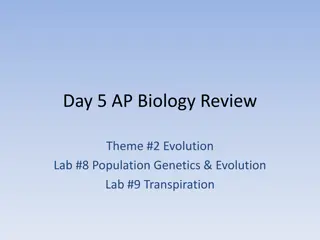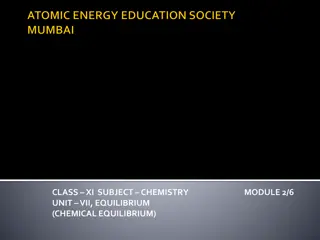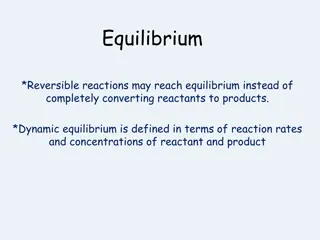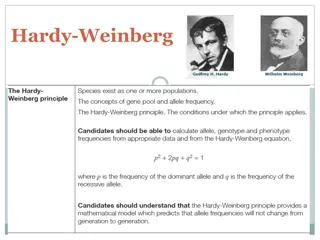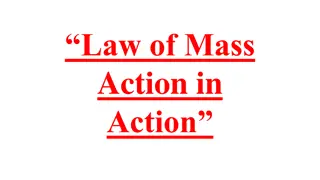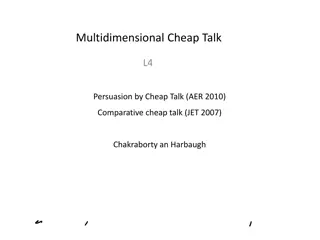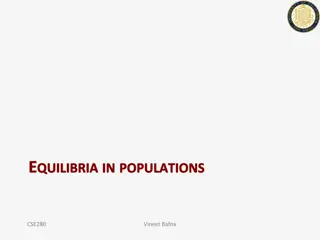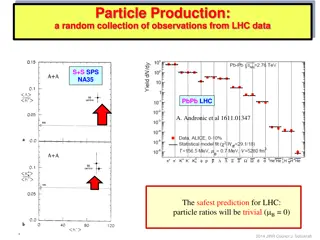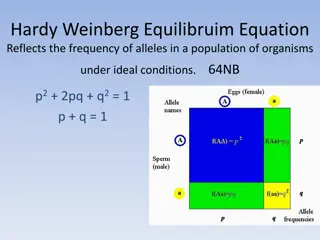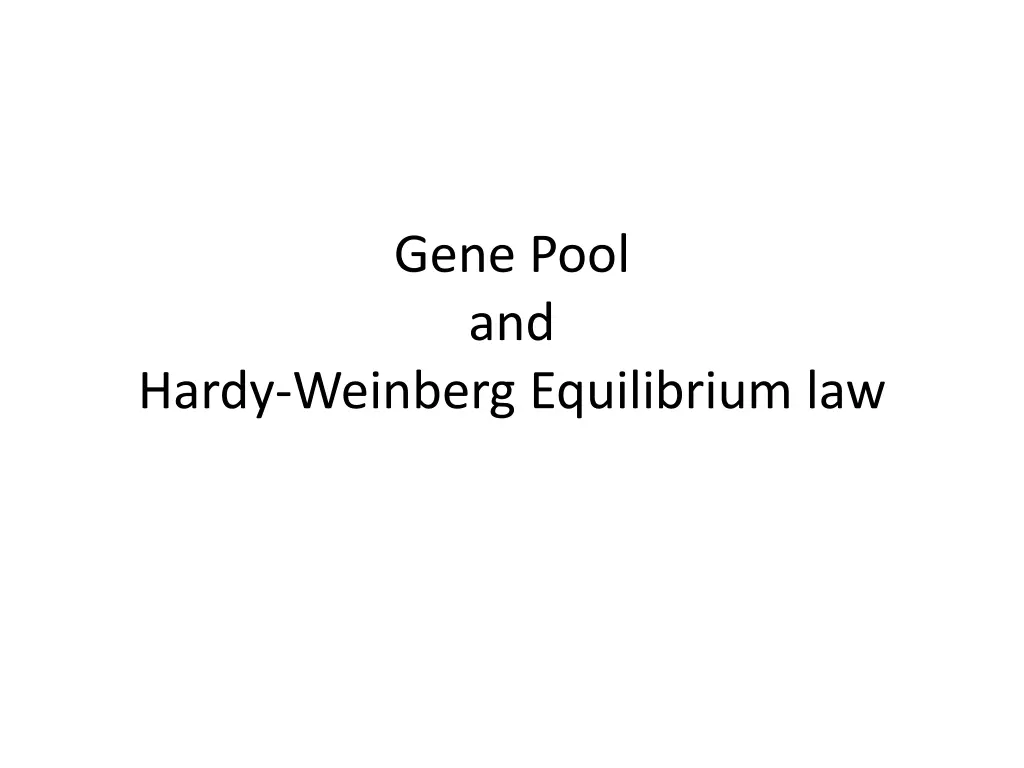
Understanding Gene Pools and Hardy-Weinberg Equilibrium
Explore the concept of gene pools and the Hardy-Weinberg equilibrium law, essential for understanding genetic diversity and population health. Discover the significance of gene frequency, genetic variation, and the impact on species survival and fitness.
Download Presentation

Please find below an Image/Link to download the presentation.
The content on the website is provided AS IS for your information and personal use only. It may not be sold, licensed, or shared on other websites without obtaining consent from the author. If you encounter any issues during the download, it is possible that the publisher has removed the file from their server.
You are allowed to download the files provided on this website for personal or commercial use, subject to the condition that they are used lawfully. All files are the property of their respective owners.
The content on the website is provided AS IS for your information and personal use only. It may not be sold, licensed, or shared on other websites without obtaining consent from the author.
E N D
Presentation Transcript
Gene Pool and Hardy-Weinberg Equilibrium law
Total number of genes in a particular species is called gene pool
Gene Pool The total number of genes of the population( species) is called Gene Pool Population: a group of individuals present in one particular area at a given time and capable of interbreeding is called a population A large gene pool indicates extensive genetic diversity, which is associated with robust populations that can survive bouts of intense selection. Meanwhile, low genetic diversity can cause reduced biological fitness and an increased chance of extinction When all individuals in a population are identical with regard to a particular phenotypic trait, the population is said to be 'monomorphic'. When the individuals show several variants of a particular trait they are said to be polymorphic.
If we look across a population of 1,000 fruit flies living in a jar, we might identify a total of 20 different alleles that occupy locus 1 on chromosome 1. Those 20 alleles are the gene pool for that locus. The set of all alleles at all loci is the full gene pool for the species. A small gene pool is generally bad for a species because it reduces variation. Some of the common genetic problems that occur when the gene pool shrinks include: Low fertility Deformities Genetic diseases A large gene pool provides a good buffer against genetic diseases.
Example Suppose we want to find out the genetic information about the smooth (W) and wrinkled (w) pea seeds in the pea plant population and want to find out the % of homozygous dominant, heterozygous and recessive plants. It is possible to know them based on the following if we start with equal proportion of W and w alleles, then in the state of equilibrium we will get the genotype ratio of - WW, - Ww and - ww ( Monohybrid Cross Ratio) this is true only in a condition in which random mating occurs
In 1908, Hardy and Weinberg gave a mathematical formula to find out the gene and the genotype frequency of a particular gene in a population What is gene frequency? it refers to the proportion of allele in the gene pool as compared with other alleles of the same gene
For Example for a gene there are only two alleles namely A and a . A is dominant and a is recessive. Now the possible genotype combinations will be -AA, Aa and aa. Calculation of Gene Frequency suppose there are 100 individuals in a population of with genotypes of AA = 40, Aa =40 , aa= 20 then total number of genes in the gene pool = 100 X 2 = 200 (100 individuals and 2 alleles) Number of gene in homozygous dominant (AA) individuals (40) = 40 + 40 = 80 Number of gene in heterozygous (Aa) individuals (40) = 40 So the total number of gene A allele = 80 + 40 = 120 Gene Frequency of A allele = 120/200 = 0.6
Number of recessive allele in homozygous recessive (aa) individuals (20) = 20 + 20 = 40 Number of allele in heterozygous (Aa) individuals (40) = 40 So total number of recessive alleles = 40 + 40 = 80 Gene frequency of recessive allele (a) = 80/200 = 0.4 If the gene frequency of A allele is represented by letter p If the gene frequency of a allele is represented by letter q Then at gene equilibrium condition the total frequency if represented by p + q = 0.6 + 0.4 = 1 ie p + q = 1 p = 1-q q = 1 -p
Calculation of Genotype Frequency Genotype frequency is calculated by the formula (p + q)2 that is (p + q) 2 = p2 + 2pq + q2 that means gene frequency of A allele = p gene frequency of a allele = q = 1-p genotype frequency of A A = p2 genotype frequency of aa = q2 genotype frequency of Aa = 2pq
Suppose the genotype frequency of aa (q2) = 0.04 Then Gene frequency of a = square root of 0.04 = 0.2 So Gene frequency of A (p) = 1-q = 1- 0.2 = 0.98 Genotype frequency of AA (p2) = P X P = 0.98 X 0.98 = 0.9604 Genotype frequency of Aa (2pq) = 2 X 0.98 X 0.2 = 0.392 Thus by knowing the genotype frequency of any one allele we can calculate the frequency of other allele
Hardy Weinberg Equilibrium Definition : the relative frequency of alleles in the population remains constant from generation to generation in a population of sexually reproducing organisms it is true under following conditions : 1. The population is large enough so that accident of sampling may be ignored 2. Mating takes place at random 3. Mutation does not take place or if it does, the rate is same in both directions 4. All the members of the population survive and have equal reproduction rates
Equation Hardy weinberg equlibrium states that in a randomly interbreeding large population, the allele frequency does not change. And the gene and genotype frequency is represented by the equation (p + q )2 = 1 ( p2 + 2pq + q2) = 1
Factors affecting the Hardy-Weinberg equilibrium Mutations : sudden, large and inheritable changes in the genetic material Mutations are random (indiscriminate) and occur in all directions. Most mutations are harmful or neutral Rate of mutation is very low, i.e. one per million genie loci Certain mutations are preadaptive and appear even without exposure to a specific environment. Significance of mutations create and maintain variations within a population introduce new genes and alleles in a gene pool Accumulation of mutations over a number of generations may lead to speciation
2. Recombination during Sexual Reproduction Recombination involves reshuffling of genes of chromosomes. Chances of recombination are more in those organisms which undergo sexual reproduction which involves gametogenesis followed by fertilization. Crossing over: It involves the exchange of genetic material between the non-sister chromatids of homologous chromosomes By independent assortment of chromosomes: During anaphase I, homologous chromosomes move towards the opposite poles. This results in reduction of chromosome number. Variations occur during the chance arrangement of bivalents during metaphase I of meiosis
By random fertilization: It involves the chance fusion of gametes Significance: Due to recombination s, though only reshuffling of already existing characters takes place . Different combinations bring diversity in genotype and phenotype of different organisms.
3. Genetic Drift According to Hardy-Weinberg principle, in infinitely large , randomly mating population the gene frequency either remains constant or exhibits a directional change under the influence of natural selection But in small population the gene frequency exhibits great non-directional fluctuation purely by chance. As a result the genetic architecture of small population changes irrespective of selective advantage or disadvantage These random changes in gene frequency which is not under the control of natural selection is called Genetic Drift Genetic drift always influences frequencies of alleles and is inversely proportional to the size of population
Theory of genetic drift was given by Sewall Wright (1930). It is also called as Sampling Error / Sewall Wright effect / Scattering of Variability . Effects of Genetic Drift on Gene Frequency 1. Homozygosity: in small population, due to genetic drift the gene frequency continue to fluctuate until one of the allele is lost. This leads to homozygosity. That means genetic drift reduces genetic variability in small population. 2. Fixation of New Mutations: since genetic drift eliminates one allele, so a mutation which is present in the lost allele will be lost or a mutation in the allele which is present will be fixed. 3. Genetic Divergence: the small population ( demes) become progressively genetically different. In each subpopulation, the genes fixed or lost will be different and over a period of time these demes will diversify and form a new species
genetic drift is most important in very small populations Genetic drift occurs when a small group separates from a larger population and may not have all the alleles or may differ from the parental population in the frequencies of certain genes. This explains for the difference between island populations and mainland population. genetic drift can cause dramatic changes in the allele frequencies in a population derived from small groups of colonisers, called founders, to a new habitat. These founders do not have all of the alleles found in their source population. These founders become quickly different from the parental population and may form a new species, e.g. evolution of Darwin finches on Galapagos Islands which were probably derived from a few initial founders.
When a few individuals or a small group of individuals from a large population are isolated in a geographical region, they become the founders. These founders carry only a limited portion of the parental gene pool. Their gene pool may contain certain alleles in low frequency or they may lack a few alleles. Since these founders are not able to interbreed with their parental population due to geographical isolation, inbreeding occurs and these founders become genetically different from their parental population and form a new species.
Population bottleneck/ Bottleneck effect It is reduction in allele frequencies caused by drastic reduction in population size called population crash e.g. decrease in cheetah population in Africa due to over-hunting. population bottleneck often prevents the species to reestablish its former richness so new population has a much restricted gene pool than the larger parent population.
5. Gene Flow Gene flow is defined as the diffusion of genes into population through migrations and interbreeding. Gene flow helps in reversing the loss of variability as a result of genetic drift. Most populations are only partially isolated from other populations of same species. Usually some migration- emigration occurs between the populations Immigration results in the addition of new alleles into the existing gene pool and changes the allele frequencies
6. Natural Selection The process by which comparatively better adapted individuals out of a heterogeneous population are favoured by the Nature over the less adapted individuals is called natural selection. It means that those individuals, which are best adapted to the environment, survive longer and reproduce at a higher rate and produce more offsprings than those which are less adapted. So the formers contribute proportionately greater percentage of genes to the gene pool of next generation while less adapted individuals produce fewer offsprings. If differential reproduction continues for a number of generations, then the genes of those individuals which produce more offsprings will become predominant in the gene pool of the population
So natural selection causes progressive changes in gene frequencies, i.e. the frequency of adaptive genes increases while the frequency of less adaptive genes decreases.


